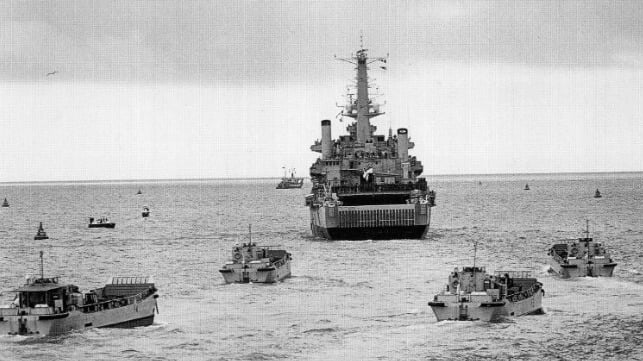Falklands at 40: Royal Navy Hunts for Campaign's Last Missing Vessel
Veterans launch a search for the wreck to bring closure for families of six missing sailors

Royal Navy and Royal Marines amphibious experts and veterans of 1982 are making a determined effort to finally find the "lost wreck" of the Falklands Campaign. Through painstaking research, highly-accurate computer modeling, and detailed understanding of weather and sea conditions, they hope to narrow down the search area based on where Landing Craft Foxtrot 4 was last sighted.
Six crewmen were killed when the vessel was bombed late on June 8 1982. The tragedy is often overshadowed by the attack on RFAs Sir Galahad and Sir Tristram earlier that same day - the biggest single loss of British lives in the conflict.
The 40th anniversary of the tragedy was commemorated aboard amphibious flagship HMS Albion this week. The ship's crew were joined by Rear Admiral Jeremy Larken – in 1982, the commanding officer of HMS Fearless, Albion’s predecessor and Foxtrot 4’s ‘mother ship’.
There has never been a determined effort to find the remains of Foxtrot 4, although in recent years RN survey vessels visiting the Falklands have conducted spasmodic searches. That may change thanks to the small team of veterans of 1982 – including Rear Admiral Larken – and serving personnel who’ve dedicated several years to trying to pinpoint the wreck site.
After the craft – which was ferrying Land Rovers and Royal Signallers from Goose Green to Fitzroy to support the final assault on the Falklands capital, Stanley – was bombed, the surviving two crew and nine soldiers were rescued by helicopter.
The coastal supply vessel Monsunen, seized back from the Argentinians, attempted to take the landing craft under tow. Her crew – who included the future First Sea Lord Admiral Sir Phil Jones – struggled until nearly first light on June 9 when the crippled boat was finally abandoned.
“The locations of all other ships lost in the conflict are known,” said former HMS Fearless and 4th Assault Squadron landing craft officer Lieutenant Colonel Richard Thurstan. “The men lost on them have graves at sea that their families and friends can identify. The men of Foxtrot 4 have no known grave other than the sea – and finding her would bring overdue closure for the families.”
John Prime, in 1982 Navigator and Operations Officer of HMS Fearless, has pored over official documents, charts, the testimonies of survivors to pinpoint where the landing craft was attacked, and where, having drifted helplessly through the night, was last seen on the surface.
“Where she went next has been a mystery for 40 years – when a search resumed after daylight on June 9th, Foxtrot 4 was nowhere to be seen,” he said.
In addition, the team are using the latest technology to ‘rebuild’ the landing craft – in her damaged state – as a 3D model based on the original plans from 1962.
If the craft didn’t drift over the horizon into the expanse of the South Atlantic, the wreck – about 25 meters long – probably lies in water 40 to 60 meters deep, surrounded by the remains of the Land Rovers.
The opinions expressed herein are the author's and not necessarily those of The Maritime Executive.
